I'm Afro-Brazilian and visited Brazil for the first time during Carnival. The trip felt like coming home, and I can't wait to go back.
Malik Peay

- In February, I spent a week in Rio de Janeiro, Brazil, with friends for the Rio Carnival festival.
- Seeing the floats and performers, and places my Brazilian grandpa told me about, felt magical.
I'm part Brazilian but before this past February, I had never visited Brazil. That changed when I traveled to Rio De Janeiro to attend Carnival.
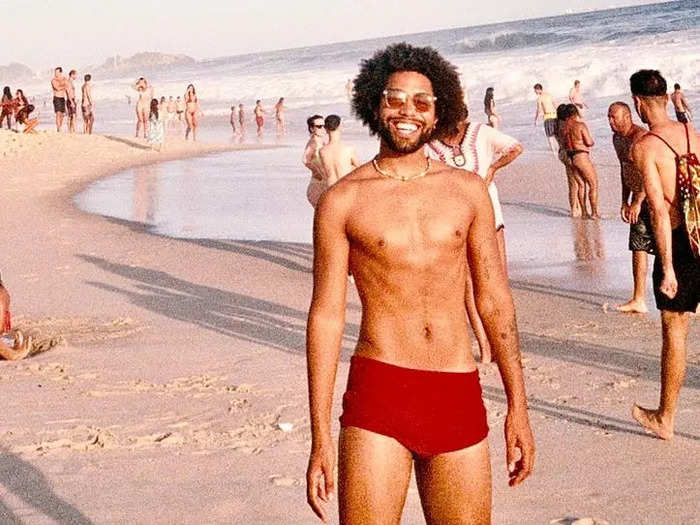
My grandpa, Roberto, immigrated from Brazil to Los Angeles when he was in his teens and since then, lost most of his mother language of Portuguese. My mom and I were then born in the states, and while I grew up knowing I was part Brazilian, I never went there. I also never had a true sense of what Brazil was like, except through my grandpa's nostalgic storytelling.
But I'd grown up dreaming of visiting Brazil and knew one day I would make that happen.
That trip ended up taking place last month, when I decided to travel from my home in Los Angeles with a group of friends to Rio de Janeiro, to experience the annual event of Carnival.
Carnival, or carnaval in Portuguese, is a multi-day festival held in Rio de Janeiro each year.
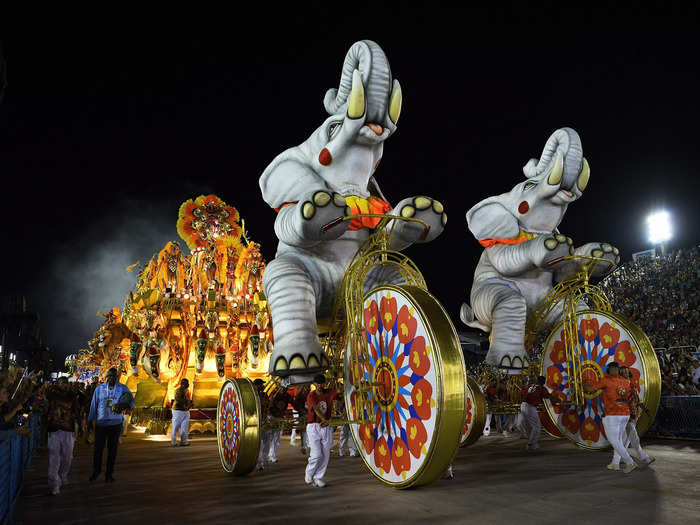
Carnival takes place in the week leading up to the start of Lent, typically late February. There are multiple parades, and other events like dance performances that take place in the Sambadrome Stadium, a massive venue with a capacity of 90,000.
I didn't know what to expect going into the trip, but I was glad to be going with friends. It turned out a better experience than I imagined, and nine moments gave me the feeling that I was coming home to my culture.
Arriving in Rio, I immediately noticed that everyone looked like me. It made me feel more connected to where my family came from.
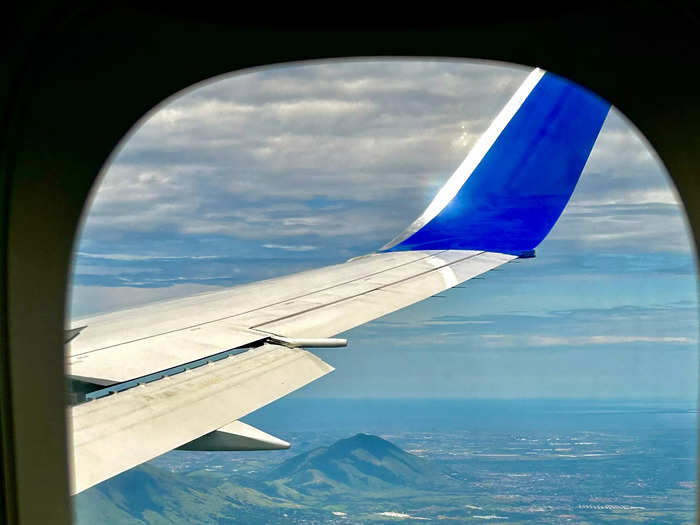
Starting from the airport in Rio and throughout the trip, everyone I met spoke to me primarily in Portuguese.
I rarely heard locals speaking other languages like English or Spanish. Being spoken to in Portuguese was exciting because it made me feel like I was regarded as a local, but also a challenge, as I know just a few words and conversational phrases.
But I quickly fell into sync with the Brazilian style of greeting people — I received many tight hugs and multiple pecks on both cheeks from people I met. I loved that it's normalized in Brazil to greet people with warmth and friendliness, and it made me feel welcomed.
My friends and I bought tickets for the stadium where Carnival performances happen, and I thought seeing the extravagant floats up close was incredible.
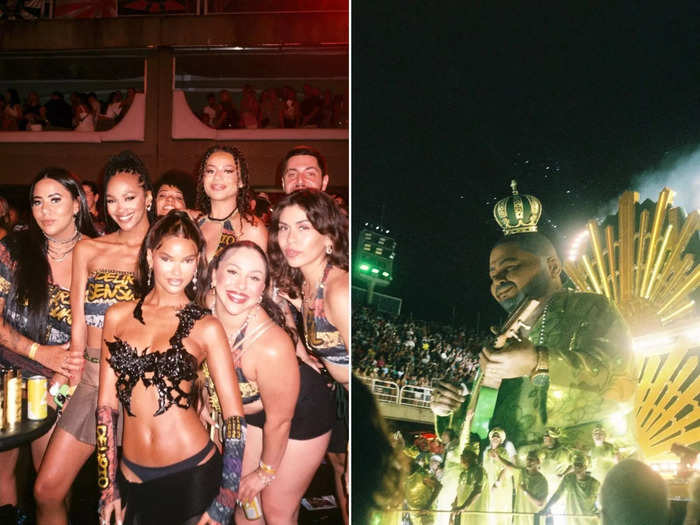
Carnival's parades and dance performances took place all day long in the Sambadrome Stadium.
On multiple days, friends and I sat in a booth seating section for our friend's samba dance school, Beija-Flor, which had a float and performers in the parades. Each float was sponsored by a different local samba dance group, and each group had a reserved seating area, called a camarote, where guests wore matching T-shirts or outfits to support and applaud the difference dance schools.
It was festive and boisterous inside our booth, and interacting with dancers in the parades who came up to us made me feel like we were all one big, supportive family.
Attending the parade was emotional for me, because many of the people on the floats were also Afro-Brazilians who looked like me. I loved seeing how much the Carnival festivities are invested in and celebrated, and it made me feel proud of my heritage.
I saw other attendees singing proudly and some brought to tears as paraders danced by.
I was shocked to learn that dancers practice for a year to be in the parade, and the floats take months to create. I felt a sense of pride for the hard work that local artists put into making Carnival happen.
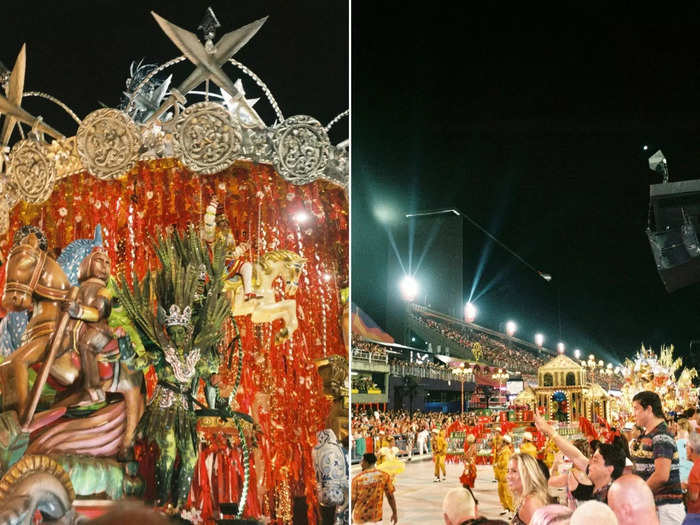
In the stadium, performances by dancers from the samba schools were scheduled all day long, with each school performing for several hours. The dances were beautiful to watch, and I was blown away by the scale of the floats and the attention to detail in the decorations and costumes.
My Brazilian friends told me that the samba schools prepare for Carnival for a full year. Besides performances, each school also creates their own song for that year's festival. These local friends knew the song for our booth's school by heart, and in the crowd, I heard many other parade attendees singing their school songs, too.
In the audience, I could feel how excited everyone was to join in the celebration. I also learned that winning the best samba school is a big deal — my Brazilian friends said the winning group gets a trophy, champion title for the year, and is often congratulated by Brazilian celebrities, musicians, and politicians in attendance.
I knew of Carnival's party scene reputation, but I saw the real side of Rio at street parties put on by locals outside of the stadium, with pop-up bars, DJs, and more.
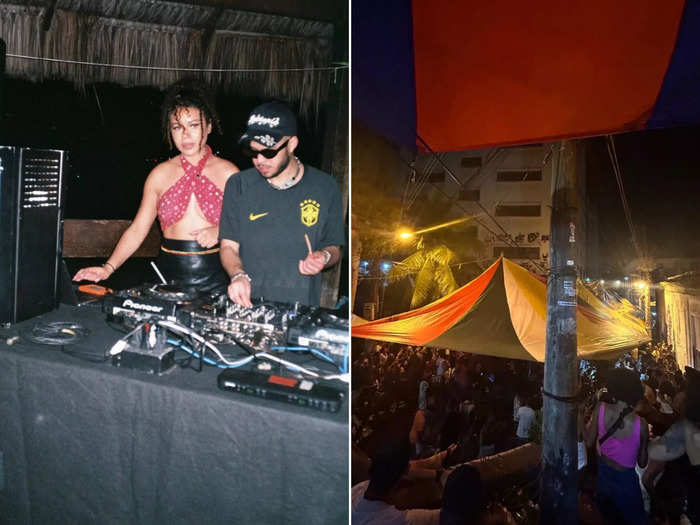
Outside of the main stadium, my friends and I also went to block parties, or bloccos, thrown by local DJs, brands, and vendors.
There were ticketed bloccos, but my friends and I mostly went to the free parties set up by locals, and I thought they were a lot of fun.
At these street parties, I saw DJs playing music from makeshift tents, food booths selling snacks, and mini bars serving drinks. Many of the parties lasted long into the night, ending as late as 5 a.m. I saw people of all ages dancing for hours into the morning, including little kids cheering at the break of dawn.
I loved the feeling of joining the street parties and dancing all night to Brazilian funk and samba. I could see how people loved to show off their Brazilian pride and dance moves for hours into the night, and I saw the sunrise everyday of the trip.
Joining in these unofficial Carnival celebrations outside of the parade made me feel like I was getting a true sense of Rio's culture. In the week I was there, the partying didn't seem to stop.
One afternoon to relax, my friends and I drove to Dois Irmãos, a mountain peak near Rio's beaches that I'd only ever seen in pictures. Finally seeing it in person felt surreal.

For our weeklong stay, my friends and I rented a hillside beach manor in Joá, a neighborhood in the west zone of Rio, near a beach called Praia da Joatinga.
After a few days of Carnival festivities, we decided to spend a relaxing afternoon driving to the base of Dois Irmãos, or Two Brothers Hill, which is a peak intersecting several of Rio's beach neighborhoods known for climbing and trailing.
I grew up admiring pictures of this mountain even though I'd never seen it in person, because my grandpa would always tell us about his many trips to the mountains and beaches near Rio.
When I finally saw Dois Irmãos in person, after years of knowing it from photos and tourism ads for Brazil, it felt surreal. It put it into perspective that I was standing in a place I'd always hoped to visit, where my grandpa grew up, and admiring a view that he saw on a regular basis many decades ago.
Besides Carnival, my weeklong trip included many afternoons at Ipanema Beach in Rio, which was the liveliest beach I'd ever been to, and where I saw how locals relax.
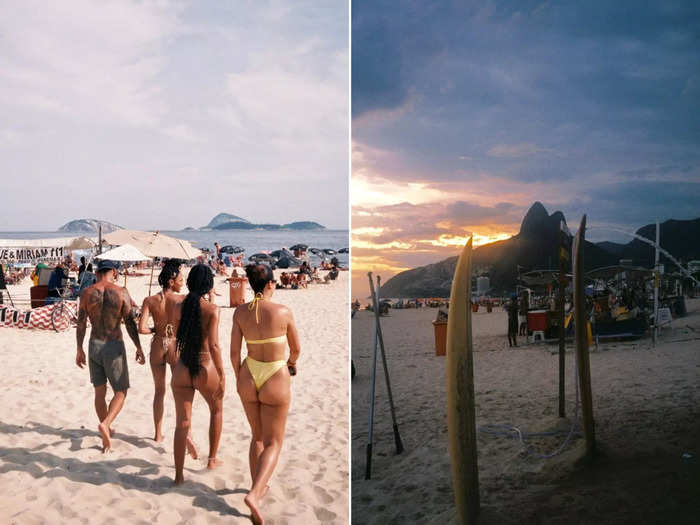
My friends and I also spent time almost every afternoon at world-famous Ipanema Beach in Rio, which was 30 minutes by car from where we were staying.
I had high expectations for Ipanema, both from my grandpa's stories and because the beach was made iconic by the 1962 Brazilian song, "The Girl from Ipanema."
When we arrived, I thought I'd never seen as many people at a beach before, including popular beaches I've been to in LA, like in Santa Monica.
Ipanema was probably the liveliest beach I've been to — the sand was packed with people playing music, vendors selling snacks and beverages, and friends playing football and volleyball. It was my first time at a beach with so many sunshade umbrellas and people tanning on towels, many of them nude.
I also saw surfers riding the waves, families picnicking with young kids, and friend groups like mine enjoying the sun. Ipanema Beach struck me as a place where all walks of life come together to enjoy the sand and ocean. I felt welcomed, and loved going back almost every day of the trip.
Throughout the trip, I tried different types of Brazilian food. All the dishes I had were hearty and fulfilling, and felt like comfort food.

I was looking forward to eating Brazilian food during the trip, as I'd never eaten authentic fare before, besides at Woodspoon, a Brazilian kitchen in downtown Los Angeles.
My Brazilian friend said it was important to eat well before and after going out for Carnival to have enough energy for the day-long celebrations.
At one restaurant for breakfast before Carnival, I devoured a bowl of mushroom soup and rice, served with a side of farofa, a local specialty dish of toasted cassava flour meant to be sprinkled over the soup. At Ipanema Beach, I ate at a beachside eatery called Sel'd Ipanema, where I had one of my favorite meals on the trip — cooked octopus with black rice and a side of mushrooms.
To balance my palate and stomach, I also frequently picked up Brazilian acai from Maria's, a local smoothie and acai chain with multiple locations around Rio. I liked that they served my acai in a drinking cup, rather than a bowl, so it was easy for me to carry. And although sometimes my frozen acai melted in the summer humidity, I still enjoyed it as a juice.
I appreciated that everything I ate in Rio was not only delicious, but also food meant to be comforting and nourishing.
Another thing I loved about the local culture in Rio was how welcoming everyone was, and how easy it was to make new friends.
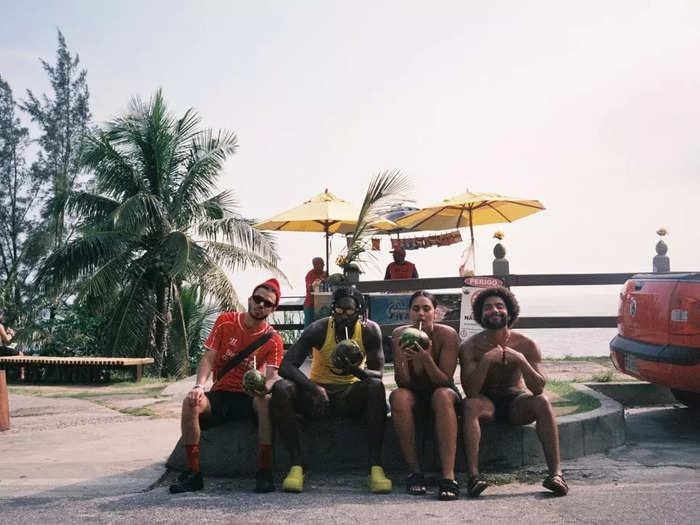
My final day in Brazil was spent decompressing at the beach, and I had an encounter that reminded me how friendly Rio's atmosphere was.
As my friends and I were enjoying the sun, we met a Brazilian bikini designer who traveled from Hawaii for Carnival. She handed some tops to my friends, and they had an impromptu photoshoot on the sand.
After, she showed us around the best hidden beaches near Joá, and we all walked together to another beach, Praia da Joatinga, that reminded me of California's beachfront Orange County. We sun-bathed and chatted, and parted ways in the late afternoon.
Making this new friend, as well as the many other friendly interactions I had throughout the trip, showed me how welcoming Rio was. It made me happy to feel welcomed and make new connections from a shared Brazilian heritage and celebration of Carnival.
My first trip to Brazil was everything I hoped it would be and more, and I left feeling more in touch with my Afro-Brazilian roots.

Rio was just as wonderful as I'd pictured as a little kid listening to my grandpa's stories. From joining Carnival festivities and block parties, to relaxing on the beaches and trying authentic food, I thought everything during the trip helped me connect with my heritage.
Participating in my first Carnival was more than just a vacation for me. It felt surreal to finally see places and events I'd always imagined, and I came back to the US with a deeper appreciation for my Afro-Brazilian culture.
I plan to return to Brazil soon to visit my grandpa's family in a city about three hours northeast of Rio. I also hope to return for another Carnival, as this trip was my favorite international excursion so far.
Popular Right Now
Popular Keywords
Advertisement